
Environment endangering life in Jaffna
[TamilNet, Tuesday, 04 January 2011, 00:31 GMT]
News reports from the south of the island, Saturday, said that Colombo government had yielded to the protests of fishermen and Church in the south, and had dropped a project to have sea planes in the Negombo lagoon. The fishermen in and around Negombo feared affliction to fish catch by the sea plane project. But on the same day, a budding young environmentalist having concern for the sand dunes and the drinking water of his people was shot dead in Jaffna. SL military intelligence occupying Jaffna and paramilitary are suspected. An academic in Jaffna brings out the environmental background of the issue.
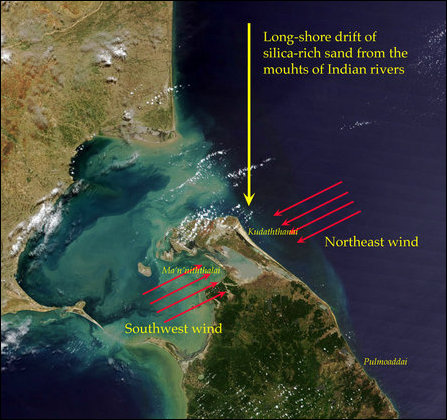
The formation of sand dunes in the Jaffna peninsula. Note the sandbanks stretching from the Indian coast. [Satellite Image Courtesy: NASA, Visible Earth. Details & Legend: TamilNet]
The Jaffna Peninsula has two stretches of sand dunes, formed by the alternate wind systems of southwest and northeast monsoons.
The Ma'n'niththalai sandbar off the peninsula in the southwest is orientated to the southwest wind, while the Vadamaraadchi sand bar is orientated to the northeast wind.
The Vadamaraadchi sandbar is formed by sand that comes from the mouths of the east-flowing rivers of India. This sand that comes to Jaffna through long-shore drift within the continental shelf that links India and the island, is deposited as sand dunes along the northeast coast of the peninsula, by the northeast wind.
This silica-rich sand, that actually doesn't belong to the limestone terrain of Jaffna Peninsula, is highly valuable in the production of glass. The resource has to be reserved and has to be exploited with much care.
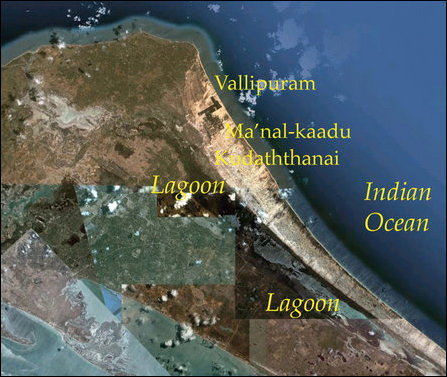
Hemmed between Indian Ocean and Tho'ndaimaanaa'ru lagoon, silica-rich golden sand deposited by Northeast Wind making the Northeast coast of Jaffna peninsula. [Satellite Image Courtesy: Google Earth, Details & Legend: TamilNet]
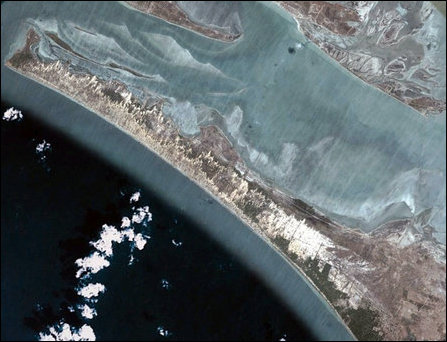
The Ma'n'niththalai sandbar showing sand deposited by the Southwest Wind. This sand largely comes from disintegrated coral of Adams Bridge reef and is white in colour. [Satellite Image Courtesy: Google Earth]
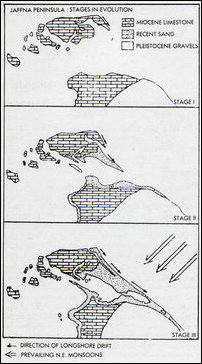
Stages of the formation of Jaffna peninsula [Image Courtesy: Dr. R. Mathanakaran, Geonomics of water resources in the Jaffna peninsula, 1978]
The golden sand dunes of Vadamaraadchi, seen at present, have a history of at least 2000 years, as archaeological remains earlier to the times are found at the bottom of them in an ilmenite layer. Pulmoaddai, a continuity of the coast, where pre-Christian era archaeological remains were destroyed in scooping ilmenite after removing the top layer of golden sand, is a good example to understand the stratigraphy.
The Vadamaraadchi sand bar links the peninsula with the main island.
The Indian Ocean is on the east of the sand bar, and on the west of it lies the long narrow lagoon called Tho'ndaimaan Aa'ru. For a very long time, beginning from the Dutch period, developers were thinking of making this lagoon a fresh water reservoir, to help paddy cultivation and to improve potable groundwater in the peninsula.
Any disturbance to the sand bar at any point of it, will cause sea water coming in, will make the lagoon saline and will seriously affect limestone groundwater in Valikaamam and non-limestone groundwater in Thenmaraadchi and Pachchilaippa'l'li.
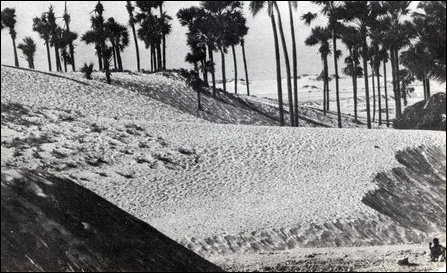
The sand-dunes of Ma'natkaadu, Kudaththanai, photographed in early 1980s [Image Courtesy: Early Settlements in Jaffna]
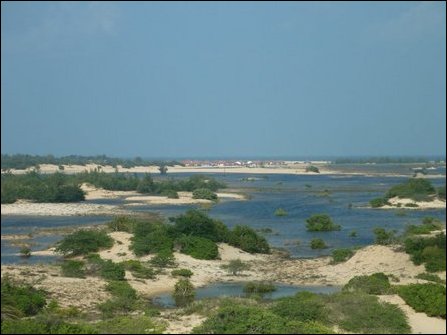
Sea water coming inside in areas scooped of its sand dunes at Kudaththanai. Photographed recently by Ketheeswaran Thevarajah killed on Friday.
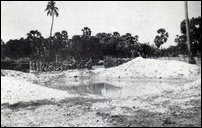
Dune sands serving small fresh water ponds for cultivation and drinking water purposes, photographed in Pachchilaippa'l'li in the early 1980s [Image Courtesy: Early Settlements in Jaffna]
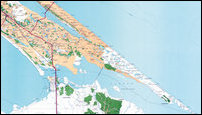
Note the innumerable fresh water ponds in the sandy stretches of Pachchilappa'l'li and Vadamaraadchi East [Image Courtesy: One Inch Sheet, Survey Department]
Already, there is a concern that the Indian-assisted revival of the KKS cement factory and limestone quarrying in the High Security Zone of Valikaamam are going to affect limestone groundwater as well as public health by causing respiratory problems in the densely populated Valikaamam region of the Jaffna Peninsula.
At present, the best groundwater resource in the peninsula, after the limestone groundwater, is found in the Pachchilaippa'l'li sand dunes. Some decades back there were even plans for a drinking water supply scheme in the peninsula to draw saline-free groundwater from the Pachchilaippa'l'li sand dunes.
Exploitation of sand dunes in the fragile ecology of Jaffna, against the backdrop of escalating demand for building material, has to be handled in a sustainable way.
But, who is the judicious authority to come out with the required environmental management and what trust people of the land have on that authority are questions that go into the realm of the national aspirations of Eezham Tamils.
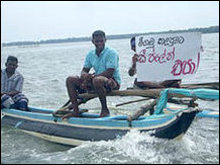
The succesful protest of Negombo fishermen against deployment of sea-plane in the Negombo lagoon [Image Courtesy: Union of Cathelic Asian News (UCANEWS.COM) 31 December, 2010]

Environmentalist Ketheeswaran Thevarajah, who was killed in Jaffna on 31 December 2010 by a killer squad for compiling information on environmental damage by scooping sand in Vadamaraadchi, Jaffna.
28.06.10
Sand dunes scooped at Ma'n'niththalai 21.06.10
Illegal excavation of limestone threatens ecology of Jaffna 03.08.08
Portending danger for potable water in Jaffna
















